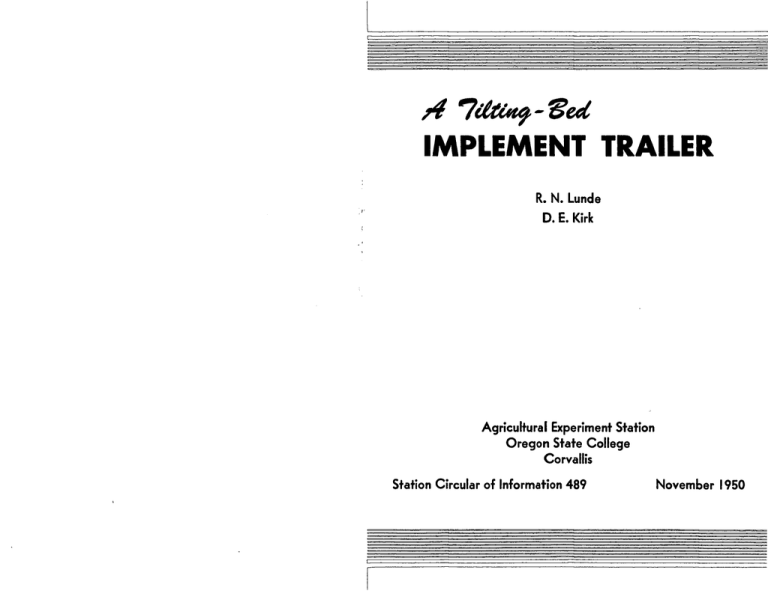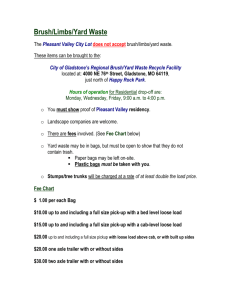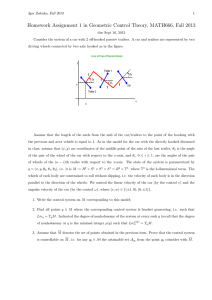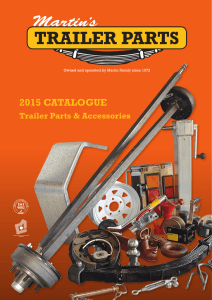IMPLEMENT TRAILER /t 7du*tf-'3ed 0
advertisement

/t 07du*tf-'3ed IMPLEMENT TRAILER R. N. Lunde D. E. Kirk Agricultural Experiment Station Oregon State College Corvallis Station Circular of Information 489 November 1950 ,-4 ldUH9-Scd IMPLEMENT TRAILER R. N. Lunde, Associate Agricultural Engineer and D. E. Kirk, Assistant Agricultural Engineer The implement trailer design shown on the accompanying plan is one which has been found to be very practical, economical, and relatively easy to construct. Many of this type have been constructed and are in service. The axle, hubs, and wheels are best obtained from an old l-ij-ton truck. This gives parts which are sufficiently heavy and wheels which will take the large tires necessary if the trailer is to carry its maximum useful loads. Tires of 7.50" x 20" size are recommended, though smaller ones could, of course, be used if the larger size is not available. The spindles of the old front axle should first be arc-welded to the axle with the wheels in the straight-ahead position. Care must be taken that the wheels are properly aligned when this is done in order that the trailer will track properly and that the tires will not be scuffed from misalignment wear. The axle should then be cut in the center and lengthened by means of the double channels, forming a box section. The axle ends should be welded into one channel before the other is put on and edge-welded to the first. Be sure the tread is such that the extreme measurement over the hub caps, or whatever sticks out farthest on each end, is less than eight feet. The plan does not give any tread dimension, due to the variation in wheels, tires, and hubs. The main point is to keep the over-all width less than 8 feet if the trailer is to be used on the highway at any time. The bed length may be varied to suit individual needs, though the one shown is very satisfactory for most hauling. If the bed center is located slightly behind the axle, it will stay tilted ready for loading. The hitch length also can be varied, depending on what is to be used to pull the trailer and how much clearance is needed on the front corners for turning short. Stake sockets can be located around the platform edge for holding removable sides if the trailer is to be used for loose hay or similar loads. The material contained in this circular has been revised from and is to supersede Station Circular of Information 356, now out of print. Fenders are used on many of these trailers, though not shown on the plan. These might be old automobile fenders remodeled or, better yet, just wide, fairly heavy band iron curved over the wheels. Old steel tractor wheel rims do very well for this purpose. The inside, vertical surfaces can be made of heavy sheet metal. o When loading tractors or other machinery, the complete trailer frame and bed is tilted down at the rear (see "Loading Position" on plan), the tongue remaining hitched to the towing unit. As the center of weight of the load passes over the axle, the bed automatically tilts to the running position and the hold-down bolt is secured. For loading machines not self-propelled, a hand-operated winch at the center of the front end is a very useful attachment. This can be mounted close to the deck and operated by a detachable extended crank at the outside edge. A block and tackle arrangement is often used in place of the winch. Some type of lock on the tilting-bed hold-down nut at the front is advisable to prevent its working loose. Handles welded onto this nut will make a powerful wing-nut of it, thus eliminating the need for a wrench. The use of a good strong safety chain at the hitch also is recommended, in case the hitch pin should work or break loose. The trailer described in this circular will weigh about 1000 to 1100 pounds and will require a license ($10.00) if it is to be used on the highway. The trailer will carry safely all the load the tires will stand. LOADING POSITION SECTION B-B ■SECTION A-A ELEVATION C0OP£RATIVt EXTtNSION WORK IN A6RICULTURE a HOME ECONOMICS NOTE: FROMrAXLE, HUBS 4 WHEEta TAKEN FROM UK/) li-TON T/tl/CM. CVTAXLC IN CCtfTEGi LCN6THEN AS SHOWN. AKC-WELD STEEL MEDtBEHa. . ftECMOHENOEO TIRC 'SISE~ 7. SO * £0. OREGON STATE COLLEGE CORVALLIS, OREGON PLANS BY AGRI. EN6IN££RlNS E3«? STATION IMPLEMENT TRAILER PLAN NO ail DRAWN flV RNL 12/4.4 Rtvon) IW~ID SHEET I Of I



